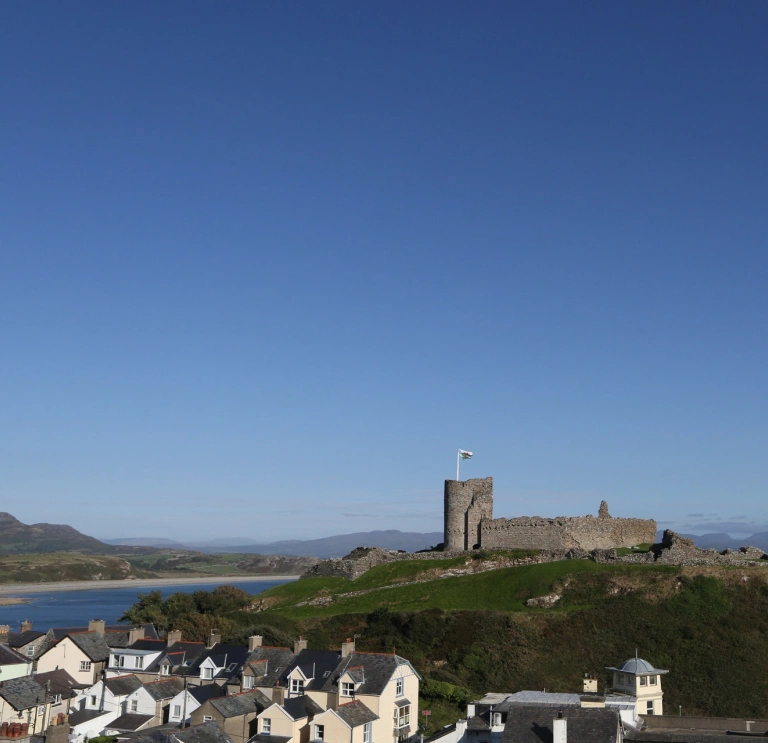Deganwy Castle, Conwy
On a rocky outcrop overlooking Conwy, the castle at Deganwy was a powerbase of post-Roman Wales. By the 6th century it was the HQ of Maelgwn, one of the earliest kings of Gwynedd. In later centuries it was rebuilt and destroyed several times, and there’s not much left of it now – a series of mysterious mounds and ruined walls on the hill - but it offers great views across to Castell Conwy (Conwy Castle).


St Cwyfan’s Church, Anglesey
By the 9th century, power had shifted to the House of Aberffraw on Anglesey. The royal court was dismantled and its stones used to build Castell Biwmares (Beaumaris Castle), but at least St Cwyfan’s Church has survived on its tidal rock. The little ‘church in the sea’ dates from the 12th century, and it’s still used for services and massively photogenic weddings.

Castell Rhuddlan (Rhuddlan Castle)
When you look south from the chunky remains of Castell Rhuddlan (Rhuddlan Castle), Edward I’s masterpiece of 1277, there’s a conical lump called Twtil. This is the motte of an earlier castle, which may have been built on top of the royal palace of Gruffydd ap Llywelyn, the only Welsh king ever to rule over the entire territory of present-day Wales, from 1057 until his death in 1063.

Dinas Emrys, Beddgelert
The craggy plinth of Dinas Emrys has attracted fort-builders since the Iron Age, up to and including Llywelyn the Great (1173–1240). There are few remains on top of the wooded hillock, but it’s worth visiting for the lovely Nantgwynant landscape, and for its legendary status. King Vortigern, so the story goes, was trying to build a castle here, but the walls kept collapsing. A boy wizard – Merlin – identified the cause: two dragons, one white and one red, fighting in a pool beneath the castle. The red dragon won, and with it the considerable honour of appearing on our national flag.
Beddgelert
Talking of good yarns, Llywelyn the Great’s trusty dog, Gelert, is buried in the pretty village of Beddgelert, unjustly slain by his master after protecting a baby prince from a marauding wolf. Back on less shaky historical ground, St Mary's Church is built on the site of an Augustinian priory supported by Llywelyn.


Castell Dolbadarn (Dolbadarn Castle), Llanberis
Here’s another display of Llywelyn the Great’s might. Castell Dolbadarn (Dolbadarn Castle) is a classic Welsh round tower, built to guard the spectacular Llanberis Pass that threads between the Yr Wyddfa (Snowdon) and Glyderau massifs. It’s a must-visit before walking or taking the nearby Snowdon Mountain Railway up Wales’ highest mountain, or a boat across the lake.

Castell Cricieth (Criccieth Castle)
Perched on a headland between two beaches, Castell Cricieth (Criccieth Castle) was first built in stone by Llywelyn the Great, beefed up by his grandson Llywelyn ap Gruffudd, and given a Norman facelift by Edward I – all within the 13th century. Then along came rebellious Owain Glyndŵr in 1404 and set it on fire; some stones still bear the scorch marks. Incidentally, Llywelyn ap Gruffudd was our last sovereign Prince of Wales.



Cymer Abbey, Llanelltyd
Follow the River Mawddach up from Barmouth and you’ll soon stumble across the ruins of Cymer Abbey. It was founded in 1198 by Maredudd ap Cynan, a notable warrior and cousin of Llywelyn the Great. The Gwynedd nobility were generous patrons to the Cistercians, and in return the monks here supplied their lordships with pedigree horses.

Castell y Bere
When they weren’t fighting Normans, the Welsh princes were busy scrapping with each other. Castell y Bere was born out of a family dispute. Llywelyn the Great was displeased with the way his son Gruffudd was ruling Meirionnydd, so he imprisoned his son and built a new castle. If a job’s worth doing, etc. Later on, the Normans abandoned the castle and left it to crumble, but that’s part of the magic of this unexpected gem, set in the beautiful Dysynni Valley in the shadow of Cader Idris.

Castell Dolwyddelan (Dolwyddelan Castle), Conwy
Native Welsh castles always seem to be in the prettiest places (the Normans were more boringly pragmatic). The square tower of Castell Dolwyddelan (Dolwyddelan Castle) looks gorgeous on its rocky plinth, overlooking the site of an earlier castle, Tomen Castell – probably the birthplace of Llywelyn the Great. Edward I later garrisoned troops at Dolwyddelan, issuing them with white uniforms for winter warfare.

Llys Rhosyr, Anglesey
Until the Normans showed up, the Welsh princes didn’t need heavily-defended stone castles. Instead, they ruled their lands from a series of llysoedd or courts, moving between palaces. Almost all were destroyed or built over, but the site of Llys Rhosyr has survived. So far a quarter of the llys has been excavated; the rest awaits rediscovery. From here, head down through the dunes of Newborough Warren to the wildly romantic Ynys Llanddwyn (Llanddwyn Island).







